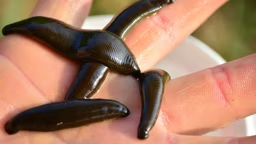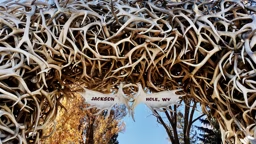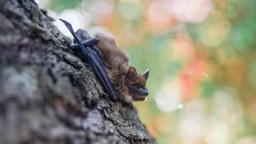Specialized body adaptations
Although turtle features vary greatly by species, they in general have thickly scaled legs, long claws, webbed feet, a long neck and powerful jaws. Adaptations and positions of the beak, eyes and nostrils reveal volumes about the lives of turtles, as form so often follows function in the natural world.
Many varieties of North American turtles live on plants and berries, fresh fish and insects, and even the rotting carrion sinking and floating in our waters.
Softshell turtles have long, snorkel-like noses and very long necks, allowing these turtles to remain hidden underwater for hours on end. The snapping turtle has eyes of a mottled-camouflage coloration near the top of the skull, allowing for crocodile-like ambush.
In some species of turtles, females and males have different feeding adaptations, hence different builds of the face, head and neck. Among common map turtles, for example, females have a much more robust, powerful build to the body, neck and head, and they use this to advantage in crushing shelled invertebrate animals.
As adaptation goes, the painted turtle is remarkably successful – it’s the most abundant turtle species in North America. And it’s immediately recognizable by its smooth, black, domelike carapace, bright yellow stripes on a black face and neck, and bright, orange-red plastron outlining a dark, jagged “oak leaf” pattern.
Throughout its range, the painted turtle’s carapace and plastron markings vary somewhat, but the color scheme is more or less the same. Why painted turtles are the most common turtles in many North American lakes, rivers and wetlands may very well be for the simple reason that this turtle represents the absolute average of all things turtle. Medium size, medium build and a no-nonsense set of average adaptations allow this turtle to eat well and live well wherever wetlands exist.
Although turtle features vary greatly by species, they in general have thickly scaled legs, long claws, webbed feet, a long neck and powerful jaws. Adaptations and positions of the beak, eyes and nostrils reveal volumes about the lives of turtles, as form so often follows function in the natural world.
Many varieties of North American turtles live on plants and berries, fresh fish and insects, and even the rotting carrion sinking and floating in our waters.
Softshell turtles have long, snorkel-like noses and very long necks, allowing these turtles to remain hidden underwater for hours on end. The snapping turtle has eyes of a mottled-camouflage coloration near the top of the skull, allowing for crocodile-like ambush.
In some species of turtles, females and males have different feeding adaptations, hence different builds of the face, head and neck. Among common map turtles, for example, females have a much more robust, powerful build to the body, neck and head, and they use this to advantage in crushing shelled invertebrate animals.
As adaptation goes, the painted turtle is remarkably successful – it’s the most abundant turtle species in North America. And it’s immediately recognizable by its smooth, black, domelike carapace, bright yellow stripes on a black face and neck, and bright, orange-red plastron outlining a dark, jagged “oak leaf” pattern.
Throughout its range, the painted turtle’s carapace and plastron markings vary somewhat, but the color scheme is more or less the same. Why painted turtles are the most common turtles in many North American lakes, rivers and wetlands may very well be for the simple reason that this turtle represents the absolute average of all things turtle. Medium size, medium build and a no-nonsense set of average adaptations allow this turtle to eat well and live well wherever wetlands exist.
Earth-incubated eggs
Despite all of their aquatic adventures, turtles nest on land and are remarkable in their abilities to fashion nests in a variety of soils and sands. A turtle migrates away from the open water and finds land, high and dry, in order to plant the next generation. Softshell turtles may haul out to nest just a few meters from water, but the Blanding’s turtle will migrate more than a mile to find the best nesting sites, often following a long path back to its own natal hatching site.
A gravid, or pregnant, female turtle uses its back legs to dig a deep hole with a slow, methodical switching and scratching for up to 10 hours, then settles into the laborious process of laying more than a dozen eggs. This instinctively crafted bottle-shaped nest is capped with the leftover soil and sometimes plugged with vegetation, a primitive gesture of hope by an ancient animal.
The nest provides protection and the right temperature and humidity to encourage the young to develop in time to emerge during autumn’s milder days, though some eggs may overwinter and hatch in the spring.
As the embryos develop, the gender of the young turtles can be influenced by the temperature in the nest. Which temperatures determine which genders is species-specific. For example, for mud turtles or pond turtles, temperatures under 27ºC (80.6ºF) produce males and temperatures over 30ºC (86ºF) produce females. At that very narrow temperature range in between, both male and female turtles will develop within the same clutch of eggs. In the end, a mix of habitats for turtle nests results in a random scattering of males and females.
Despite all of their aquatic adventures, turtles nest on land and are remarkable in their abilities to fashion nests in a variety of soils and sands. A turtle migrates away from the open water and finds land, high and dry, in order to plant the next generation. Softshell turtles may haul out to nest just a few meters from water, but the Blanding’s turtle will migrate more than a mile to find the best nesting sites, often following a long path back to its own natal hatching site.
A gravid, or pregnant, female turtle uses its back legs to dig a deep hole with a slow, methodical switching and scratching for up to 10 hours, then settles into the laborious process of laying more than a dozen eggs. This instinctively crafted bottle-shaped nest is capped with the leftover soil and sometimes plugged with vegetation, a primitive gesture of hope by an ancient animal.
The nest provides protection and the right temperature and humidity to encourage the young to develop in time to emerge during autumn’s milder days, though some eggs may overwinter and hatch in the spring.
As the embryos develop, the gender of the young turtles can be influenced by the temperature in the nest. Which temperatures determine which genders is species-specific. For example, for mud turtles or pond turtles, temperatures under 27ºC (80.6ºF) produce males and temperatures over 30ºC (86ºF) produce females. At that very narrow temperature range in between, both male and female turtles will develop within the same clutch of eggs. In the end, a mix of habitats for turtle nests results in a random scattering of males and females.
The lucky 10 percent
Turtle nests are dangerous places for the eggs. Warm-blooded omnivores, especially raccoons and crows, have learned to dig into the nests and remove a feast of would-be turtles. Some river turtles lose their eggs when summer flood waters inundate islands and sandbars, drowning the nests. Nest failures also result from habitat loss, increased road densities and vehicle traffic, and accidental encounters between nesting turtles and wandering cats and dogs – all the results of a busy human population.
As turtles migrate from wetlands to uplands to nest, they must survive the migration, find the best nesting habitat, lay their eggs successfully, and return to safe waters, all amid the din of a changing world. By the time all challenges have been surmounted, as many as 90% of turtle eggs are lost. The remaining 10% represent the year’s precious, bright new promise for the future.
Turtle nests are dangerous places for the eggs. Warm-blooded omnivores, especially raccoons and crows, have learned to dig into the nests and remove a feast of would-be turtles. Some river turtles lose their eggs when summer flood waters inundate islands and sandbars, drowning the nests. Nest failures also result from habitat loss, increased road densities and vehicle traffic, and accidental encounters between nesting turtles and wandering cats and dogs – all the results of a busy human population.
As turtles migrate from wetlands to uplands to nest, they must survive the migration, find the best nesting habitat, lay their eggs successfully, and return to safe waters, all amid the din of a changing world. By the time all challenges have been surmounted, as many as 90% of turtle eggs are lost. The remaining 10% represent the year’s precious, bright new promise for the future.
Basking in the sun
On a hot summer day, turtles divide their time between a cool swim and a relaxing time basking in the sun. Turtles, being cold-blooded animals, rely on the energy of the sun (and time away from the sun) to regulate the important, life-sustaining metabolic processes of their day-to-day growth and survival, including egg development in females.
Many species of turtles bask on deadwood and at the edge of a lake or river. Forested shoreline with natural deadfalls creates an ideal basking habitat, as turtles are able to haul out of the water and choose a basking spot ranging from full sun to partial shade.
Some species, such as softshell turtles, are fond of sandy beaches and gravel shorelines, and some species will perch on rocks and partially submerged logs far from shore.
Many turtles change body position while basking, maximizing surface area exposed to the sun. The common map turtle climbs surprisingly high on a sun-dried log, stretches its neck, and extends its hind legs straight behind like solar collectors. Some species of turtle are quick to bail from their basking perches when disturbed, while others are remarkably tame. Because this “relaxing” act of basking is actually serious metabolic business, it is most polite to keep your distance.
Many turtle species are thriving in our midst. But, sadly, many more are fading away. Some species are no longer reproducing well enough to ensure a future; there are more than 30 species of imperiled turtles worldwide. Conservation strategies beyond habitat protection and land acquisition include captive breeding programs, nest relocation and volunteer nest guarding. Lonesome George, the last Pinta Island giant tortoise, represented the loneliest number – one. It was thought that he would live alone for as many as 100 years more, but he passed away in June 2012 at around 100 years old. We are lucky to be able to enjoy the fascinating species that remain; their unassuming lives bring richness to ours.
Brian Collins thinks perfect basking conditions for turtles are perfect basking conditions for turtle-watchers! Don’t forget the sunscreen!
On a hot summer day, turtles divide their time between a cool swim and a relaxing time basking in the sun. Turtles, being cold-blooded animals, rely on the energy of the sun (and time away from the sun) to regulate the important, life-sustaining metabolic processes of their day-to-day growth and survival, including egg development in females.
Many species of turtles bask on deadwood and at the edge of a lake or river. Forested shoreline with natural deadfalls creates an ideal basking habitat, as turtles are able to haul out of the water and choose a basking spot ranging from full sun to partial shade.
Some species, such as softshell turtles, are fond of sandy beaches and gravel shorelines, and some species will perch on rocks and partially submerged logs far from shore.
Many turtles change body position while basking, maximizing surface area exposed to the sun. The common map turtle climbs surprisingly high on a sun-dried log, stretches its neck, and extends its hind legs straight behind like solar collectors. Some species of turtle are quick to bail from their basking perches when disturbed, while others are remarkably tame. Because this “relaxing” act of basking is actually serious metabolic business, it is most polite to keep your distance.
Many turtle species are thriving in our midst. But, sadly, many more are fading away. Some species are no longer reproducing well enough to ensure a future; there are more than 30 species of imperiled turtles worldwide. Conservation strategies beyond habitat protection and land acquisition include captive breeding programs, nest relocation and volunteer nest guarding. Lonesome George, the last Pinta Island giant tortoise, represented the loneliest number – one. It was thought that he would live alone for as many as 100 years more, but he passed away in June 2012 at around 100 years old. We are lucky to be able to enjoy the fascinating species that remain; their unassuming lives bring richness to ours.
Brian Collins thinks perfect basking conditions for turtles are perfect basking conditions for turtle-watchers! Don’t forget the sunscreen!
Stereotyped as slow and vulnerable, turtles are a richly diverse group of ancient reptiles that offer many surprises. Did you know that softshell turtles are lightning-quick? That wood turtles feast on summer berries? That an alligator snapping turtle lures fish to their doom with a wiggly worm-like lure on its tongue? Slow to grow, some turtles don’t begin reproducing until they’re 20 years old, and many make overland migrations and endure bitter winters each year. Indeed, life in the slow lane is interesting.
HOW TO HELP YOUR TURTLES
Perhaps, in times when we ourselves are traveling in the slow lane of life, we can make an effort to keep turtles around for the long haul. Here are a few ways you can help:
– Leave downed logs and trees in the water along the shoreline so that turtles have a variety of basking sites and areas of undisturbed shoreline for nesting. (Bonus: Makes for good fish habitat!)
– Groom a path from a lake, river, pond or wetland to an open, sandy and sunny area of wild habitat. Turtles prefer the path of least resistance and may follow your path toward success in nesting!
– Domestic dogs and cats may prey on turtles, so do not let them out of the cabin unsupervised!
– Keep compost piles and yards clean. Rock piles, wood piles and old building foundations can encourage mammalian predators to den. Food scraps and odors can attract these predators, to the demise of nesting turtles.
Perhaps, in times when we ourselves are traveling in the slow lane of life, we can make an effort to keep turtles around for the long haul. Here are a few ways you can help:
– Leave downed logs and trees in the water along the shoreline so that turtles have a variety of basking sites and areas of undisturbed shoreline for nesting. (Bonus: Makes for good fish habitat!)
– Groom a path from a lake, river, pond or wetland to an open, sandy and sunny area of wild habitat. Turtles prefer the path of least resistance and may follow your path toward success in nesting!
– Domestic dogs and cats may prey on turtles, so do not let them out of the cabin unsupervised!
– Keep compost piles and yards clean. Rock piles, wood piles and old building foundations can encourage mammalian predators to den. Food scraps and odors can attract these predators, to the demise of nesting turtles.
Anatomy of a turtle shell
Being reptiles, turtles are also vertebrates, backboned animals. The skin, muscle and the bones of the spine
and ribs are fused to that famous and rigid dome that so many people call the turtle’s shell. That “shell” is a paired combination of bone and skin plates, carrying a more proper set of names.
The upper “shell” is known as the “carapace,” and it offers the turtle the best means of escaping danger and seeking camouflage amid the shoreline’s natural litter. The carapace also offers the biologist the best means of quickly identifying a turtle, as each species’ carapace has a different combination of ridges, textures and colors.
The lower “shell” is known as the “plastron,” and it offers extremely varied levels of protection to a turtle’s underside. While land-dwelling box turtles have a hinged plastron that shuts tight (like a box) and provides complete protection from a meddling raccoon, snapping turtles have a tiny, cross-shaped plastron that leaves the turtle so open to danger that it needs a nasty temper and wickedly effective camouflage to protect itself.
The special scales, present as large blocks on the carapace and plastron, are known as “scutes.” These scutes can help us estimate a turtle’s age, because turtles often lay down a series of growth rings or “annuli,” much like the rings of a tree. The colors and patterns of the scutes are also very useful in identifying a turtle’s species.
Being reptiles, turtles are also vertebrates, backboned animals. The skin, muscle and the bones of the spine
and ribs are fused to that famous and rigid dome that so many people call the turtle’s shell. That “shell” is a paired combination of bone and skin plates, carrying a more proper set of names.
The upper “shell” is known as the “carapace,” and it offers the turtle the best means of escaping danger and seeking camouflage amid the shoreline’s natural litter. The carapace also offers the biologist the best means of quickly identifying a turtle, as each species’ carapace has a different combination of ridges, textures and colors.
The lower “shell” is known as the “plastron,” and it offers extremely varied levels of protection to a turtle’s underside. While land-dwelling box turtles have a hinged plastron that shuts tight (like a box) and provides complete protection from a meddling raccoon, snapping turtles have a tiny, cross-shaped plastron that leaves the turtle so open to danger that it needs a nasty temper and wickedly effective camouflage to protect itself.
The special scales, present as large blocks on the carapace and plastron, are known as “scutes.” These scutes can help us estimate a turtle’s age, because turtles often lay down a series of growth rings or “annuli,” much like the rings of a tree. The colors and patterns of the scutes are also very useful in identifying a turtle’s species.




 PhotoSpin.com
PhotoSpin.com 











